The Associated Daimler Co introduced the 416 series in 1927. It was a significant step forward in design,
introducing, like AEC's NS, a cranked chassis over the rear axle, that allowed a much lower floor to the saloon,
producing a much more modern-looking coach or bus.
The East Surrey ADC416As and AD416Ds
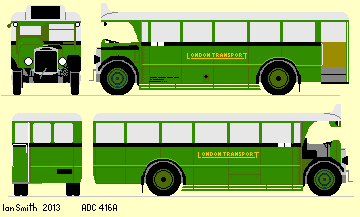 London General bought fifty ADC 416As in 1927-8 for its subsidiaries,
of which eleven were buses for East Surrey.
These were fitted with 30-seater Chiswick-built bodies
with open rear platforms and open cabs.
London General bought fifty ADC 416As in 1927-8 for its subsidiaries,
of which eleven were buses for East Surrey.
These were fitted with 30-seater Chiswick-built bodies
with open rear platforms and open cabs.
East Surrey in its own right bought fourteen of the AEC 4-cylinder ADC416As,
and also five 416Ds with the more powerful 6-cylinder Daimler engines.
These also had the same Chiswick-built B30R bodies.
The thirty buses were a standard large saloon for East Surrey,
supplemented by the later three AD426s and in the early thirties by AEC Regal T-types.
London General Country Services became their owner in 1932, so some at least went into LGCS red and white livery.
London Transport painted them green, with black bands.
They survived until 1935-36, when the 4Q4s came on stream to replace them.
The LGOC Private Hire ADC416As
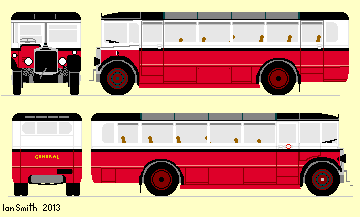 Also in 1927-28 LGOC built fourteen ADC416As for its Private Hire fleet.
Their coach bodies were also Chiswick built, and were semi-saloons,
with a canvas roof over the central seating section between the two nearside swing doors.
The canvas roof could be folded back over the rear of the vehicle in pleasant conditions.
Four were allocated to National, whilst the other ten were probably all based at Brixton.
Livery was probably red and white, with just a discrete "General" fleetname on the rear.
Also in 1927-28 LGOC built fourteen ADC416As for its Private Hire fleet.
Their coach bodies were also Chiswick built, and were semi-saloons,
with a canvas roof over the central seating section between the two nearside swing doors.
The canvas roof could be folded back over the rear of the vehicle in pleasant conditions.
Four were allocated to National, whilst the other ten were probably all based at Brixton.
Livery was probably red and white, with just a discrete "General" fleetname on the rear.
Similar bodies were later provided for AEC Reliances. This is significant because in 1929-30
it could be seen that National would need more large saloons. Rather than supply them with Reliances, to give a mixed fleet,
LGOC had the fourteen coach bodies removed from the ADCs and placed on Reliance chassis (nine extant and five new).
The nine bus bodies from the Reliances were placed on the ADCs, along with five new bus bodies by Hall-Lewis.
The new bodies were B30R like the earlier bus batch, but to an improved design, with a squarer front to the saloon,
deeper side valances and revised destination box.
They joined the earlier ADCs with National.
LGCS took over in April 1932, and London Transport in July 1933. Withdrawals began in 1933
with all of them swept away by the Q revolution in 1935-6.
The National ADC416As
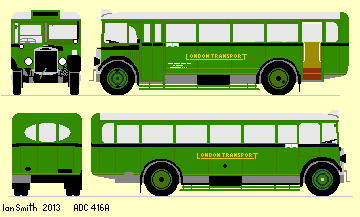 The General also supplied buses to its northern subsidiary. So when East Surrey received its eleven,
National received six with Chiswick thirty-two seater bodies,
which as well as a rear doorway had a narrow two-leaf door at the front nearside. The latter had enclosed cabs - with doors!.
Displays consisted of a single-line destination blind box above the cab.
These were known by Chiswick as AD1-6, although the numbers were not carried on the buses.
National had wanted the ADC416Ds, regarding the ADC416As as underpowered to deal with the Hertfordshire hills,
but at that time the Metropolitan Police would not allow six-cylinder engines.
The General also supplied buses to its northern subsidiary. So when East Surrey received its eleven,
National received six with Chiswick thirty-two seater bodies,
which as well as a rear doorway had a narrow two-leaf door at the front nearside. The latter had enclosed cabs - with doors!.
Displays consisted of a single-line destination blind box above the cab.
These were known by Chiswick as AD1-6, although the numbers were not carried on the buses.
National had wanted the ADC416Ds, regarding the ADC416As as underpowered to deal with the Hertfordshire hills,
but at that time the Metropolitan Police would not allow six-cylinder engines.
There were also thirty-three ADC416As to the same B30R specification as their East Surrey cousins,
and they had similar careers. These shared the numbers AD7-53 with the other fourteen from the Reliance body-swap.
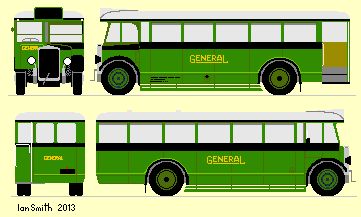
The East Surrey ADC426s
The ADC426 was an improved ADC416, with a new narrow-line deeper radiator - a Daimler car-shape radiator but without the fluting,
and new style front castings for the front chassis hangers.
The new-style Chiswick B30R bodywork as ordered by East Surrey in 1928 was a big improvement too,
with deeper side valances and an enclosed cab - with door. Altogether a big step towards the 1930s styles.
There were just three of them, which lasted until early 1936.
Then, just eight years old, they were rendered obsolete by the new generation of buses.
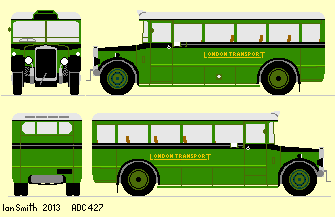
The LGOC ADC427s
In 1928 the LGOC bought two ADC427s as Private Hire coaches too.
This was the normal-control model, with a short eighteen seater forward entrance body (by Chiswick).
They were known by Chiswick as AD54 and AD55, although these numbers were never carried.
LGOC passed them on to LGCS in 1932, where they were treated as eighteen seater buses - with coach seats.
Livery in early London Transport days was green with a black waist-band and gutter, and silver-finish roof.
They lasted until May 1936, when the general purge took them away too.
Reorganisation: LGCS and LPTB
The General, conscious of the growing power of the big railway companies, combined its National operations to the north of London with its East Surrey company to the south.
Aware that "East Surrey" was not an appropriate fleetname for operations in Buckinghamshire, Hertfordshire and Essex,
it rebranded the Country operations as London General Country services.
Initial livery for single-deckers was red, with white upper bodywork, with a GeneraL Country Services fleetname.
This kept off the predators for fifteen months from April 1932 until July 1933, when the London Transport Act
cemented the country operations as part of the London Transport area.
The new board (LPTB) kept the county operations separate from the Central Area, establishing
them as the Country Area, with North and South Divisions. Engineering control stayed with Reigate initially.
Livery was changed to green, with a dark back band and aluminium-coloured roofs.
The fleetname, as in the Central Area, was initially, and insensitively, "GENERAL",
which reinforced many people's impressions that the whole thing was a LGOC takeover
forced through by Parliament. It was soon changed to "LONDON TRANSPORT".
Engineering control passed to Chiswick in 1935, when buses started to receive numbers, garage plates, and proper records.
The ADCs continued not to wear numbers - it was too late for them!
The Watford Omnibus ADC416s
National had a number of competitors in the Watford area, including the Watford Omnibus Co.
This company had three 1928 second-hand ADC416s, bought by Watford in 1931-32:
- DR3734 came from Southern National, with a Metcalfe 32-seater bus body;
- FG4697 came from W.Alexander, with a Cowieson 30-seater bus body;
- DR3734 came from Batten's Coaches, with a Hall-Lewis 29-seater coach body;
Watford Bus Company was taken over by London General in June 1933, and so passed to London Transport in July 1933.
The three ADCs continued in use until 1935.
The Batten's ADC426s
Batten's Luxurious Coaches in east London had three ADC426s when they were taken over by LT in December 1933,
with the Grays - London express service.
These, along with Batten's Reliances, were coach-bodied.
Whether they continued to be used on Green Line work after the takeover is uncertain,
but as there is no hints of such in the books about Green Line, it seems unlikely.
The double-decker
 In 1928 East Surrey had some peculiar vehicles built experimentally:
one was a lightweight double-decker aluminium body by Short Bros on a Tilling-Stevens B10A2 chassis.
Another, of interest on this page, was an ADC416A fitted with a lightweight open-top double-deck body by Short Bros.
This was then re-engined with an AEC Reliance engine. So when London Transport took over - or rather when Chiswick took over engineering in 1935,
it was numbered into the Reliance series as R44. It then was the recipient of one of the new all-metal Weymann single-decker bodies.
It survived in this guise until late 1937, when the body went to another Reliance (R40) and the odd chassis was scrapped.
In 1928 East Surrey had some peculiar vehicles built experimentally:
one was a lightweight double-decker aluminium body by Short Bros on a Tilling-Stevens B10A2 chassis.
Another, of interest on this page, was an ADC416A fitted with a lightweight open-top double-deck body by Short Bros.
This was then re-engined with an AEC Reliance engine. So when London Transport took over - or rather when Chiswick took over engineering in 1935,
it was numbered into the Reliance series as R44. It then was the recipient of one of the new all-metal Weymann single-decker bodies.
It survived in this guise until late 1937, when the body went to another Reliance (R40) and the odd chassis was scrapped.
The ADC423 Parlour Car
The General also bought just one Coventry-built 423 (a high specification version),
with a twenty-seat rear entrance coach body by Short Bros of Rochester.
Known as a parlour car, it was not nearly as sumptuous as Lord Ashfield's nine-seater parlour car.
It was for private party-hire.
It seems to have been camera-shy. Apparently not much used after 1935, it nevertheless lasted longer than its brethren, until June 1938.
It may have been numbered PR1.
Lord Ashfield's Parlour Car (YN3797)
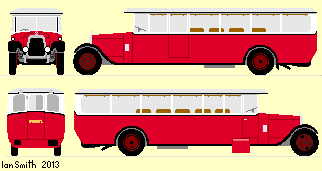 This was not an ADC. Lord Ashfield was much impressed by the work of G.J.Rackham,
who had spent some time with Yellow Coach in America before coming to Britain as designer for Leyland -
and subsequently being head-hunted by Lord Ashfield for AEC.
His new range there, with new engines, spelled an end for the AEC-Daimler partnership that was ADC,
and brought the renaissance of the AEC marque.
This was not an ADC. Lord Ashfield was much impressed by the work of G.J.Rackham,
who had spent some time with Yellow Coach in America before coming to Britain as designer for Leyland -
and subsequently being head-hunted by Lord Ashfield for AEC.
His new range there, with new engines, spelled an end for the AEC-Daimler partnership that was ADC,
and brought the renaissance of the AEC marque.
Anyway, Lord Ashfield had a Yellow Coach Y-type built to his personal specification as a nine-seater Parlour Car, in 1927.
It had nine plush leather armchairs arranged around a longitudinal central table.
The rear bay was separated off by sliding doors, presumably for attendants, as the vehicle was licensed to carry 11 passengers.
I presume that it was finished in LGOC livery, but without fleetnames. It was maintained at Chiswick.
There are excellent photos in the LT Museum photo collection (page35 of the Buses collection).

 Ian's Bus Stop
Ian's Bus Stop
 ADC main text.
ADC main text.
 ADC histories
ADC histories
 ADC photo refs
ADC photo refs
 AW
AW
